Detection of Pork in Beef Meatballs Using LC-HRMS Based Untargeted Metabolomics and Chemometrics for Halal Authentication
Abstract
1. Introduction
2. Results and Discussion
2.1. Untargeted Metabolomics Analysis Using LC-HRMS for Analysis of Meatballs
2.2. Analysis of Pork in Beef Meatballs Using Pattern Recognition Chemometrics
2.3. Analysis of Pork in Beef Meatballs Using LC-HRMS and Multivariate Calibration
3. Materials and Methods
3.1. Materials
3.2. Sample Collection and Preparation
3.3. Metabolite Extraction
3.4. Metabolomics Analysis Using Liquid Chromatography-High Resolution Mass Spectrometry
3.5. Metabolite Analysis
3.6. Chemometrics Analysis
4. Conclusions
Supplementary Materials
Author Contributions
Funding
Institutional Review Board Statement
Informed Consent Statement
Data Availability Statement
Acknowledgments
Conflicts of Interest
Sample Availability
References
- Stachniuk, A.; Sumara, A.; Montowska, M.; Fornal, E. Liquid chromatography–mass spectrometry bottom-up proteomic methods in animal species analysis of processed meat for food authentication and the detection of adulterations. Mass Spectrom. Rev. 2019, 40, 3–30. [Google Scholar] [CrossRef] [PubMed]
- Moreira, M.N.B.; da Veiga, C.P.; da Veiga, C.R.P.; Reis, G.G.; Pascuci, L.M. Reducing meat consumption: Insights from a bibliometric analysis and future scopes. Futur. Foods 2022, 5, 100120. [Google Scholar] [CrossRef]
- Orbayinah, S.; Hermawan, A.; Sismindari; Rohman, A. Detection of pork in meatballs using probe taqman real-time polymerase chain reaction. Food Res. 2020, 4, 1563–1568. [Google Scholar] [CrossRef] [PubMed]
- Fuseini, A.; Wotton, S.B.; Knowles, T.G.; Hadley, P.J. Halal Meat Fraud and Safety Issues in the UK: A Review in the Context of the European Union. Food Ethics 2017, 1, 127–142. [Google Scholar] [CrossRef]
- Li, Y.C.; Liu, S.Y.; Meng, F.B.; Liu, D.Y.; Zhang, Y.; Wang, W.; Zhang, J.M. Comparative review and the recent progress in detection technologies of meat product adulteration. Compr. Rev. Food Sci. Food Saf. 2020, 19, 2256–2296. [Google Scholar] [CrossRef]
- Stader, C.; Judas, M.; Jira, W. A rapid UHPLC-MS/MS screening method for the detection of the addition of porcine blood plasma to emulsion-type pork sausages. Anal. Bioanal. Chem. 2019, 411, 6697–6709. [Google Scholar] [CrossRef]
- Perez-Palacios, T.; Solomando, J.C.; Ruiz-Carrascal, J.; Antequera, T. Improvements in the methodology for fatty acids analysis in meat products: One-stage transmethylation and fast-GC method. Food Chem. 2022, 371, 130995. [Google Scholar] [CrossRef]
- Guntarti, A. Authentication of dog fat with gas chromatography-mass spectroscopy combined with chemometrics. Int. J. Chem. 2018, 10, 124–129. [Google Scholar] [CrossRef]
- Jia, W.; Wu, X.; Zhang, R.; Shi, L. UHPLC-Q-Orbitrap-based lipidomics reveals molecular mechanism of lipid changes during preservatives treatment of Hengshan goat meat sausages. Food Chem. 2022, 369, 130948. [Google Scholar] [CrossRef]
- Ahda, M.; Guntarti, A.; Kusbandari, A. Application of high-pressure liquid chromatography for analysis of lard in the meatball product combined with principal component analysis. Asian J. Pharm. Clin. Res. 2016, 9, 120–123. [Google Scholar] [CrossRef]
- Rahayu, W.S.; Rohman, A.; Martono, S.; Sudjadi, S. Application of FTIR spectroscopy and chemometrics for halal authentication of beef meatball adulterated with dog meat. Indones. J. Chem. 2018, 18, 376–381. [Google Scholar] [CrossRef]
- Leng, T.; Li, F.; Xiong, L.; Xiong, Q.; Zhu, M.; Chen, Y. Quantitative detection of binary and ternary adulteration of minced beef meat with pork and duck meat by NIR combined with chemometrics. Food Control 2020, 113, 107203. [Google Scholar] [CrossRef]
- Boyaci, I.H.; Uysal, R.S.; Temiz, T.; Shendi, E.G.; Yadegari, R.J.; Rishkan, M.M.; Velioglu, H.M.; Tamer, U.; Ozay, D.S.; Vural, H. A rapid method for determination of the origin of meat and meat products based on the extracted fat spectra by using of Raman spectroscopy and chemometric method. Eur. Food Res. Technol. 2014, 238, 845–852. [Google Scholar] [CrossRef]
- Perestam, A.T.; Fujisaki, K.K.; Nava, O.; Hellberg, R.S. Comparison of real-time PCR and ELISA-based methods for the detection of beef and pork in processed meat products. Food Control 2017, 71, 346–352. [Google Scholar] [CrossRef]
- Jiang, X.; Rao, Q.; Mittl, K.; Hsieh, Y.H.P. Monoclonal antibody-based sandwich ELISA for the detection of mammalian meats. Food Control 2020, 110, 107045. [Google Scholar] [CrossRef]
- Guntarti, A.; Martono, S.; Yuswanto, A.; Rohman, A. Analysis of beef meatball adulteration with wild boar meat using real-time polymerase chain reaction. Int. Food Res. J. 2017, 24, 2451–2455. [Google Scholar]
- Rohman, A.; Rahayu, W.S.; Sudjadi; Martono, S. The use of real-time polymerase chain reaction combined with specific-species primer for analysis of dog meat DNA in meatball. Indones. J. Chem. 2020, 21, 225–233. [Google Scholar] [CrossRef]
- Sarah, S.A.; Faradalila, W.N.; Salwani, M.S.; Amin, I.; Karsani, S.A.; Sazili, A.Q. LC-QTOF-MS identification of porcine-specific peptide in heat treated pork identifies candidate markers for meat species determination. Food Chem. 2016, 199, 157–164. [Google Scholar] [CrossRef]
- Zhang, M.; Li, Y.; Zhang, Y.; Kang, C.; Zhao, W.; Ren, N.; Guo, W.; Wang, S. Rapid LC-MS/MS method for the detection of seven animal species in meat products. Food Chem. 2022, 371, 131075. [Google Scholar] [CrossRef]
- Böhme, K.; Calo-Mata, P.; Barros-Velázquez, J.; Ortea, I. Recent applications of omics-based technologies to main topics in food authentication. TrAC Trends Anal. Chem. 2019, 110, 221–232. [Google Scholar] [CrossRef]
- Muguruma, Y.; Nunome, M.; Inoue, K. A review on the foodomics based on liquid chromatography mass spectrometry. Chem. Pharm. Bull. 2022, 70, 12–18. [Google Scholar] [CrossRef] [PubMed]
- Zeki, Ö.C.; Eylem, C.C.; Reçber, T.; Kır, S.; Nemutlu, E. Integration of GC–MS and LC–MS for untargeted metabolomics profiling. J. Pharm. Biomed. Anal. 2020, 190, 113509. [Google Scholar] [CrossRef] [PubMed]
- Caballero, D.; Ríos-Reina, R.; Amigo, J.M. Chemometrics and Food Traceability. In Reference Module in Food Science; Elsevier: Amsterdam, The Netherlands, 2020. [Google Scholar]
- Paul, A.; Harrington, P.d.B. Chemometric applications in metabolomic studies using chromatography-mass spectrometry. TrAC Trends Anal. Chem. 2021, 135, 116165. [Google Scholar] [CrossRef]
- Trivedi, D.K.; Hollywood, K.A.; Rattray, N.J.W.; Ward, H.; Trivedi, D.K.; Greenwood, J.; Ellis, D.I.; Goodacre, R. Meat, the metabolites: An integrated metabolite profiling and lipidomics approach for the detection of the adulteration of beef with pork. Analyst 2016, 141, 2155–2164. [Google Scholar] [CrossRef] [PubMed]
- Wang, J.; Xu, Z.; Zhang, H.; Wang, Y.; Liu, X.; Wang, Q.; Xue, J.; Zhao, Y.; Yang, S. Meat differentiation between pasture-fed and concentrate-fed sheep/goats by liquid chromatography quadrupole time-of-flight mass spectrometry combined with metabolomic and lipidomic profiling. Meat Sci. 2021, 173, 108374. [Google Scholar] [CrossRef]
- Abbas, N.; Ali, A.; Kumari, S.; Iqbal, A.; Husain, A.; Saeed, T.; AbdulAmer Al-Ballam, Z.; Ahmed, N.; El-Seedi, H.R.; Musharraf, S.G. Untargeted-metabolomics differentiation between poultry samples slaughtered with and without detaching spinal cord. Arab. J. Chem. 2020, 13, 9081–9089. [Google Scholar] [CrossRef]
- Ali, N.S.M.; Zabidi, A.R.; Manap, M.N.A.; Zahari, S.M.S.N.S.; Yahaya, N. Effect of different slaughtering methods on metabolites of broiler chickens using ultra high-performance liquid chromatography-time of flight-mass spectrometry (UHPLC-TOF-MS). Food Res. 2020, 4, 133–138. [Google Scholar] [CrossRef]
- Von Bargen, C.; Dojahn, J.; Waidelich, D.; Humpf, H.U.; Brockmeyer, J. New sensitive high-performance liquid chromatography-tandem mass spectrometry method for the detection of horse and pork in halal beef. J. Agric. Food Chem. 2013, 61, 11986–11994. [Google Scholar] [CrossRef]
- Jiménez-Carvelo, A.M.; Martín-Torres, S.; Ortega-Gavilán, F.; Camacho, J. PLS-DA vs sparse PLS-DA in food traceability. A case study: Authentication of avocado samples. Talanta 2021, 224, 121904. [Google Scholar] [CrossRef]
- Gu, X.; Sun, W.; Yi, K.; Yang, L.; Chi, F.; Luo, Z.; Wang, J.; Zhang, J.; Wang, W.; Yang, T.; et al. Comparison of muscle lipidomes between cattle-yak, yak, and cattle using UPLC–MS/MS. J. Food Compos. Anal. 2021, 103, 104113. [Google Scholar] [CrossRef]
- Galindo-Prieto, B.; Eriksson, L.; Trygg, J. Variable influence on projection (VIP) for OPLS models and its applicability in multivariate time series analysis. Chemom. Intell. Lab. Syst. 2015, 146, 297–304. [Google Scholar] [CrossRef]
- Kuswandi, B.; Cendekiawan, K.A.; Kristiningrum, N.; Ahmad, M. Pork adulteration in commercial meatballs determined by chemometric analysis of NIR Spectra. J. Food Meas. Charact. 2015, 9, 313–323. [Google Scholar] [CrossRef]
- Raharjo, T.J.; Alfiraza, E.N.; Enjelina, E.; Pranowo, D. Validation of a non-specific dye real-time PCR assay for porcine adulteration in meatball using ND5 primer. Indones. J. Chem. 2017, 17, 167–174. [Google Scholar] [CrossRef]
- Windarsih, A.; Suratno; Warmiko, H.D.; Indrianingsih, A.W.; Rohman, A.; Ulumuddin, Y.I. Untargeted metabolomics and proteomics approach using liquid chromatography-Orbitrap high resolution mass spectrometry to detect pork adulteration in Pangasius hypopthalmus meat. Food Chem. 2022, 386, 132856. [Google Scholar] [CrossRef]
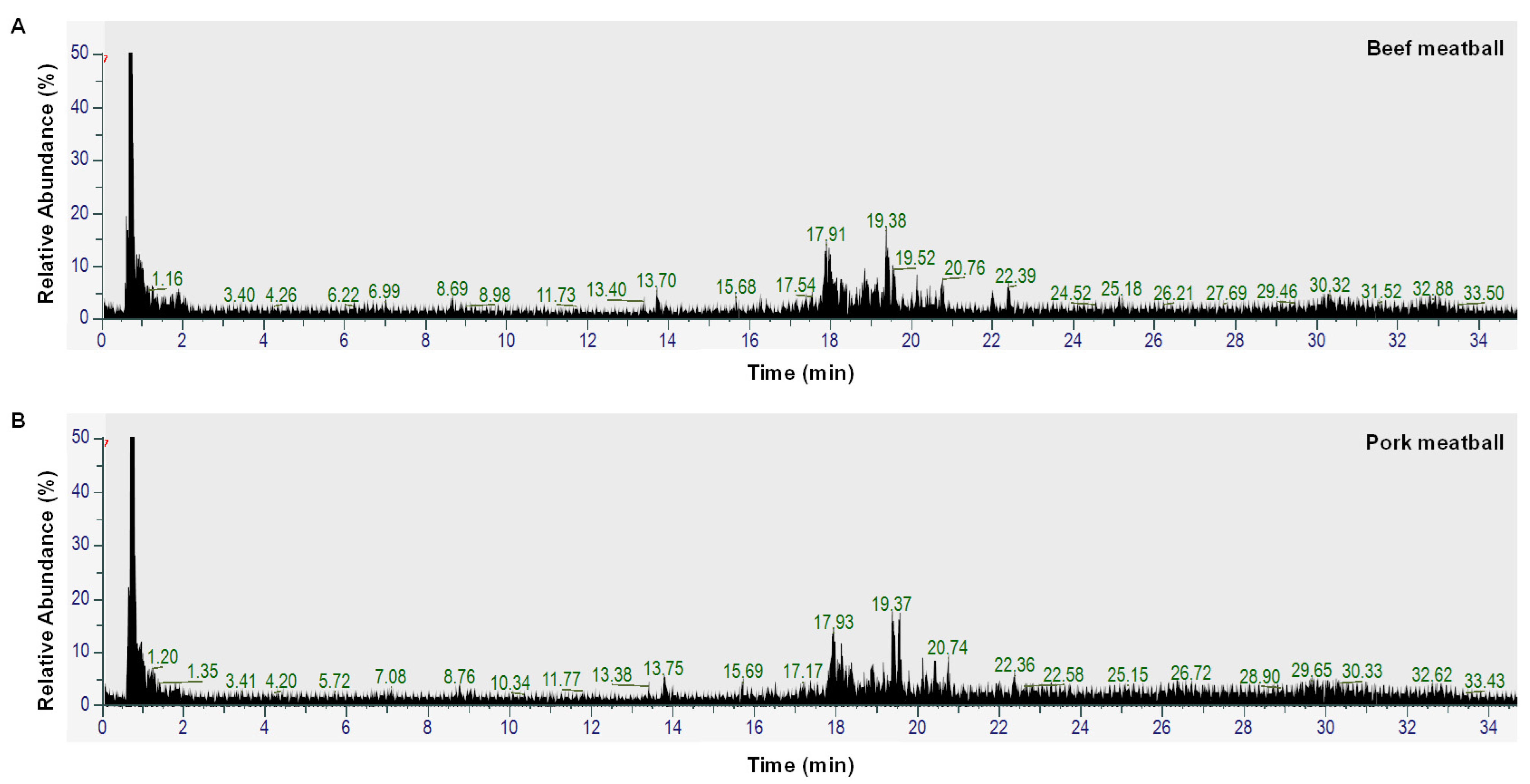
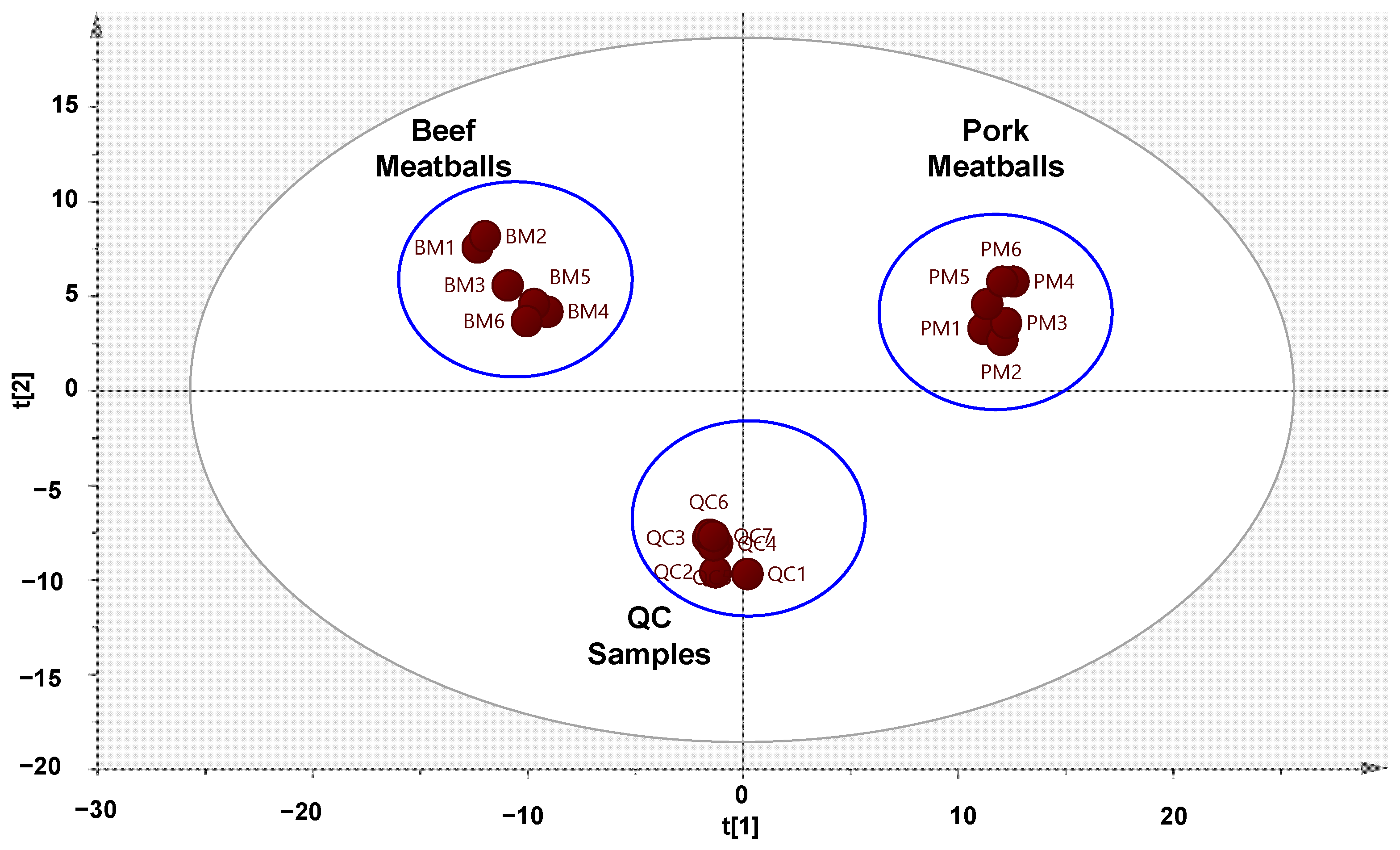
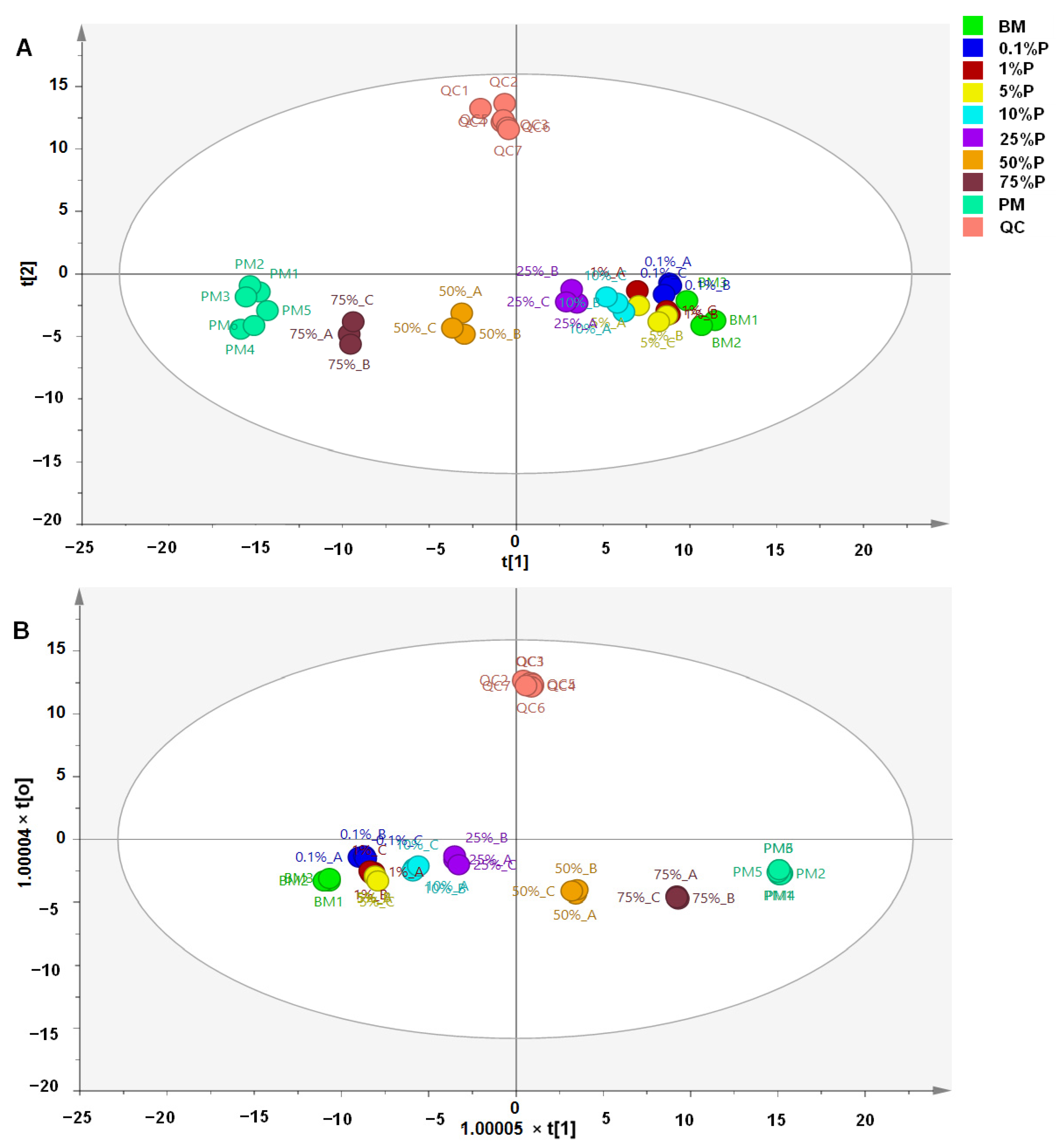
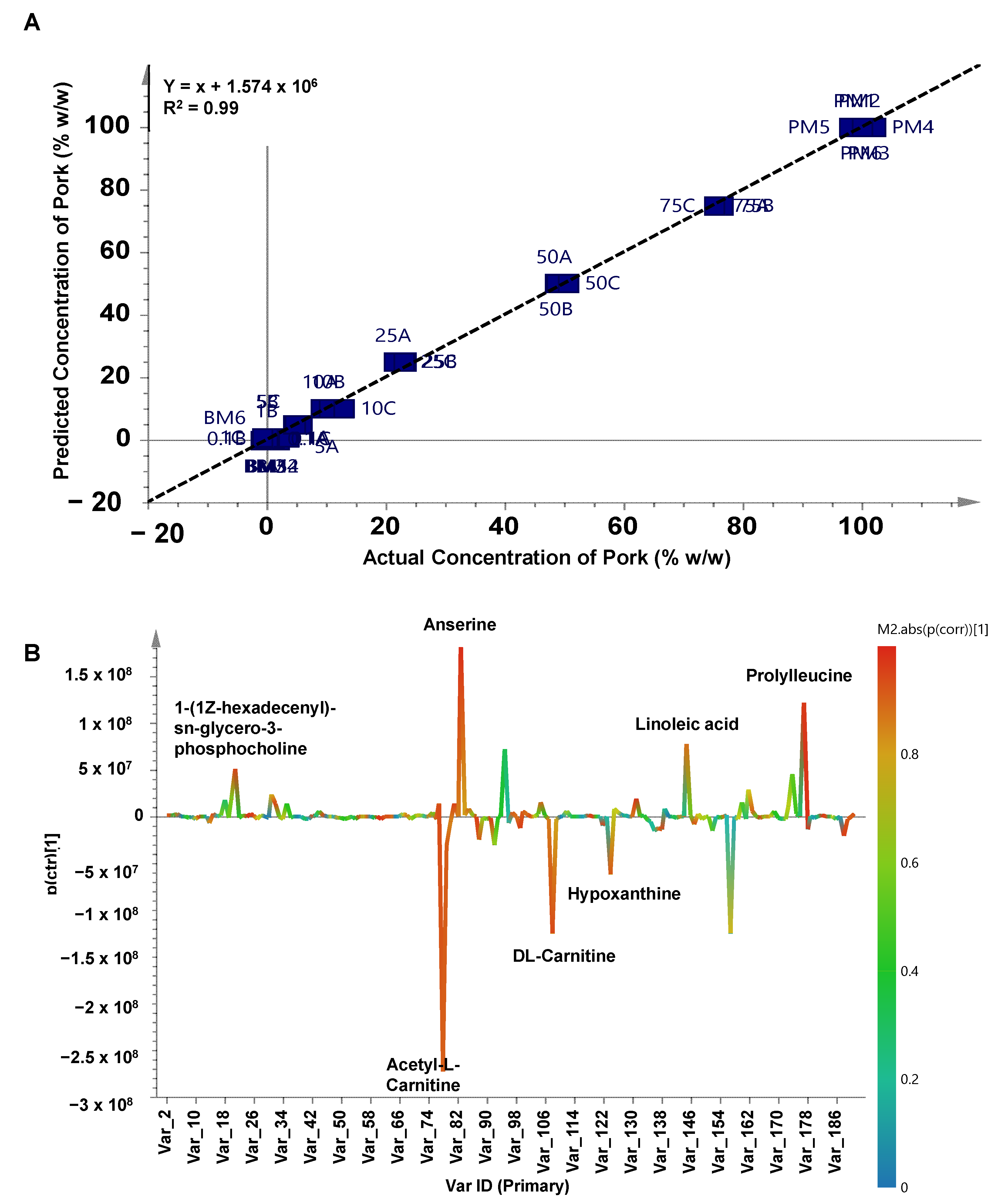
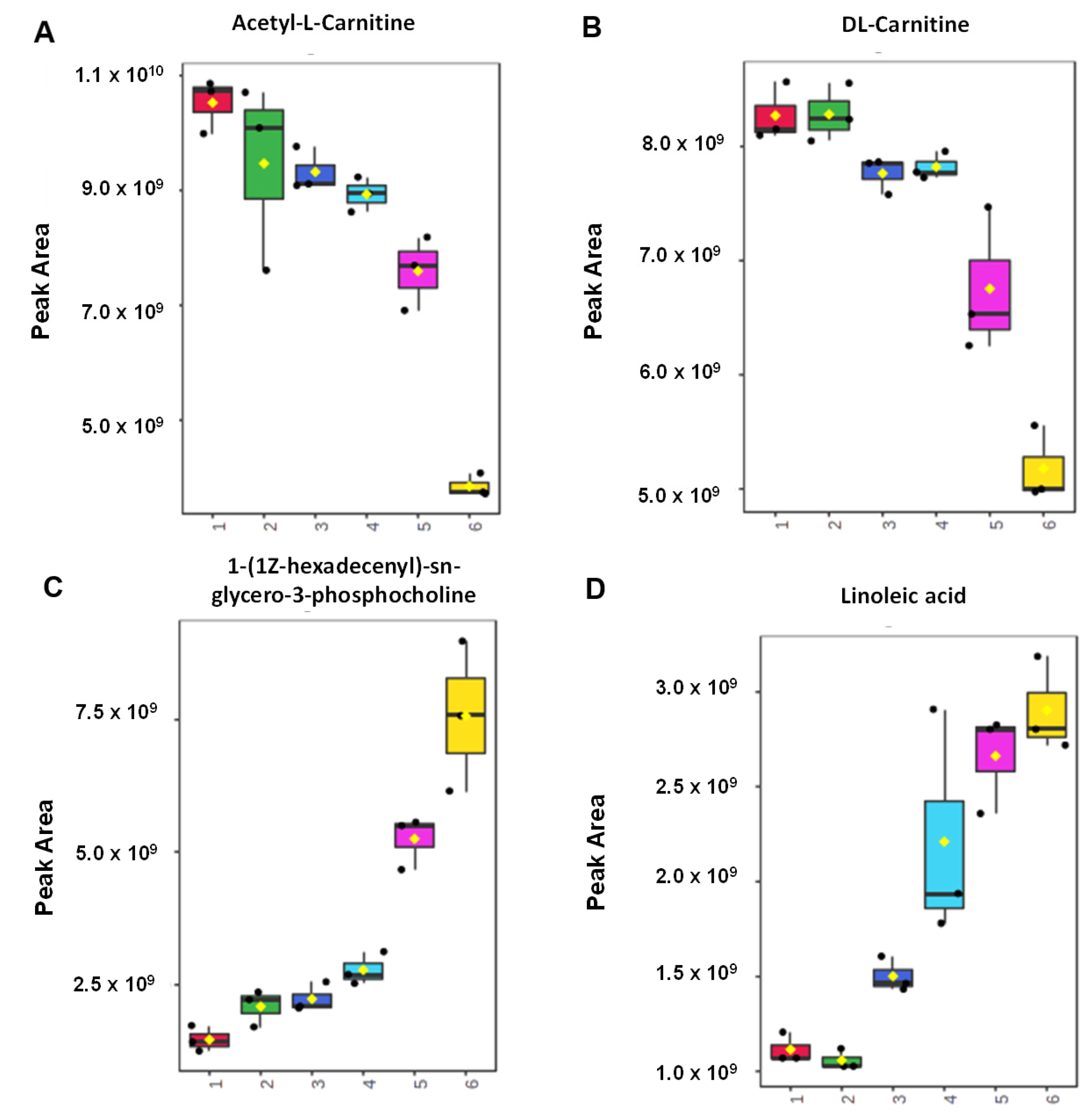
| No. | Metabolites | VIP Value | Ionization Mode |
|---|---|---|---|
| 1. | Cis-5-Tetradecenoylcarnitine | 1.67 | + |
| 2. | Leu-leu | 1.56 | + |
| 3. | Decylubiquinone | 1.55 | − |
| 4. | 3-Methylsulfolene | 1.51 | + |
| 5. | (4S)-4-{[(9Z)-3-Hydroxy-9-hexadecenoyl] oxy}-4-(trimethylammonio) butanoate | 1.49 | + |
| 6. | l-(−)-Methionine | 1.43 | + |
| 7. | N-[2,5-bis (2,2,2-trifluoroethoxy) benzoyl]-N′-(4-methoxyphenyl) urea | 1.42 | + |
| 8. | Ala-Tyr | 1.35 | + |
| 9. | (2E,4E,16Z)-1-(1-Piperidinyl)-2,4,16-icosatrien-1-one | 1.34 | + |
| 10. | (3beta,24R,24′R)-fucosterol epoxide | 1.32 | + |
| 11. | Palmitoleic acid | 1.31 | − |
| 12. | N-Stearoylsphingomyelin | 1.30 | + |
| 13. | 4-Dodecylbenzenesulfonic acid | 1.22 | − |
| 14. | 2,5-di-tert-Butylhydroquinone | 1.22 | − |
| 15. | LysoPC (22:4(7Z,10Z,13Z,16Z)) | 1.21 | + |
| 16. | 1-[(9Z)-octadecenyl]-2-hexadecanoyl-sn-glycero-3-phosphocholine | 1.21 | + |
| 17. | Trans-10-Heptadecenoic acid | 1.21 | − |
| 18. | Threonylphenylalanine | 1.20 | + |
| 19. | Nicotinic acid | 1.19 | + |
| 20. | Succinic anhydride | 1.19 | + |
| 21. | Inosine-5′-monophosphate (IMP) | 1.17 | + |
| 22. | (15Z)-9,12,13-Trihydroxy-15-octadecenoic acid | 1.16 | − |
| 23. | 1,2-Dilauroyl-sn-glycero-3-PE | 1.16 | + |
| 24. | Betaine | 1.15 | + |
| 25. | (+/−) 9-HpODE | 1.15 | − |
| 26. | 3-Hydroxy-3-[(3-methylbutanoyl) oxy]-4-(trimethylammonio) butanoate | 1.15 | + |
| 27. | α-Eleostearic acid | 1.15 | + |
| 28. | Acetyl-l-carnitine | 1.14 | + |
| 29. | N-tert-Butyloxycarbonyl-deacetyl-leupeptin | 1.14 | + |
| 30. | PC (o-18:1 (9Z)/18:2 (9Z,12Z)) | 1.14 | + |
| 31. | Docosapentaenoic acid | 1.14 | − |
| 32. | Arabinosylhypoxanthine | 1.13 | − |
| 33. | Monoolein | 1.12 | + |
| 34. | Prolylleucine | 1.11 | + |
| 35. | Propionylcarnitine | 1.10 | + |
Publisher’s Note: MDPI stays neutral with regard to jurisdictional claims in published maps and institutional affiliations. |
© 2022 by the authors. Licensee MDPI, Basel, Switzerland. This article is an open access article distributed under the terms and conditions of the Creative Commons Attribution (CC BY) license (https://creativecommons.org/licenses/by/4.0/).
Share and Cite
Windarsih, A.; Riswanto, F.D.O.; Bakar, N.K.A.; Yuliana, N.D.; Dachriyanus; Rohman, A. Detection of Pork in Beef Meatballs Using LC-HRMS Based Untargeted Metabolomics and Chemometrics for Halal Authentication. Molecules 2022, 27, 8325. https://doi.org/10.3390/molecules27238325
Windarsih A, Riswanto FDO, Bakar NKA, Yuliana ND, Dachriyanus, Rohman A. Detection of Pork in Beef Meatballs Using LC-HRMS Based Untargeted Metabolomics and Chemometrics for Halal Authentication. Molecules. 2022; 27(23):8325. https://doi.org/10.3390/molecules27238325
Chicago/Turabian StyleWindarsih, Anjar, Florentinus Dika Octa Riswanto, Nor Kartini Abu Bakar, Nancy Dewi Yuliana, Dachriyanus, and Abdul Rohman. 2022. "Detection of Pork in Beef Meatballs Using LC-HRMS Based Untargeted Metabolomics and Chemometrics for Halal Authentication" Molecules 27, no. 23: 8325. https://doi.org/10.3390/molecules27238325
APA StyleWindarsih, A., Riswanto, F. D. O., Bakar, N. K. A., Yuliana, N. D., Dachriyanus, & Rohman, A. (2022). Detection of Pork in Beef Meatballs Using LC-HRMS Based Untargeted Metabolomics and Chemometrics for Halal Authentication. Molecules, 27(23), 8325. https://doi.org/10.3390/molecules27238325








